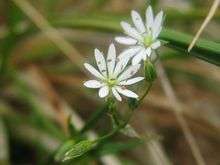Stellaria graminea
| Stellaria graminea | |
|---|---|
 | |
| Scientific classification | |
| Kingdom: | Plantae |
| (unranked): | Angiosperms |
| (unranked): | Eudicots |
| (unranked): | Core eudicots |
| Order: | Caryophyllales |
| Family: | Caryophyllaceae |
| Genus: | Stellaria |
| Species: | S. graminea |
| Binomial name | |
| Stellaria graminea L. | |
Stellaria graminea is a species of flowering plant in the Caryophyllaceae family (like pinks) known by the common names common starwort,[1] grass-leaved stitchwort,[1] lesser stitchwort[2] and grass-like starwort.[3] It is native to Eurasia but it is widespread around other parts of the temperate world as an introduced species and a common weed.[4] It grows in many types of habitat, including lawns and roadsides. It is a rhizomatous perennial herb producing branching stems which are prostrate, sprawling, trailing, or erect, and reach up to about 90 centimeters long. The stems are four-angled, weak, and hairless. It is lined with pairs of linear or lance-shaped leaves, each 1–4 centimetres (0.39–1.57 in) long. The leaves are smooth-edged and hairless except for some hairs lining the bases. The inflorescence bears several flowers, each on a short pedicel. The flower has five pointed green sepals each a few millimeters long which are usually lined with hairs. There are five white petals, each so deeply lobed it appears to be two. The seeds are reddish brown in colour and are 1 millimetre (0.039 in) in diameter.[1]
| Wikimedia Commons has media related to Stellaria graminea. |
References
- 1 2 3 "Stellaria graminea". Flora of North America. EFlora. Retrieved June 18, 2007.
- ↑ "BSBI List 2007". Botanical Society of Britain and Ireland. Archived from the original (xls) on 2015-02-25. Retrieved 2014-10-17.
- ↑ "Stellaria graminea". Natural Resources Conservation Service PLANTS Database. USDA. Retrieved 1 December 2015.
- ↑ "Stellaria graminea". GRIN Species Profile. Retrieved June 18, 2007.